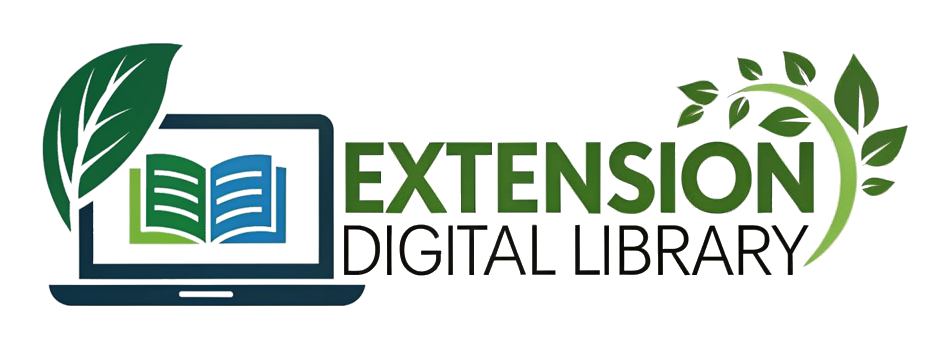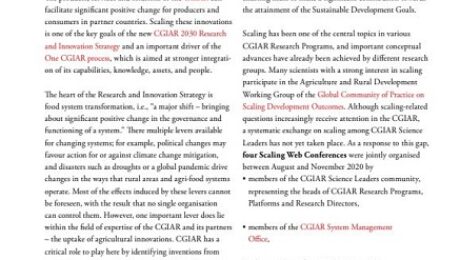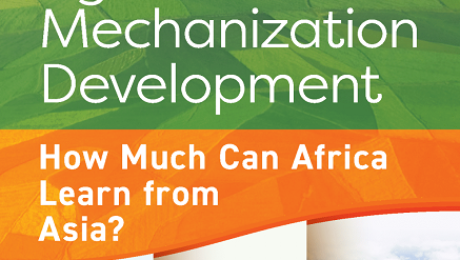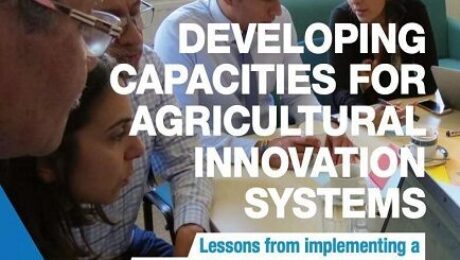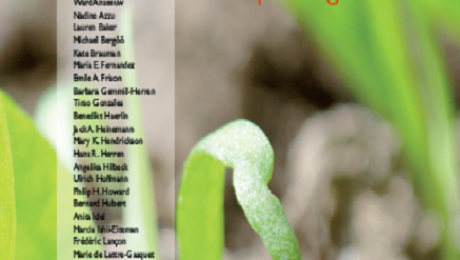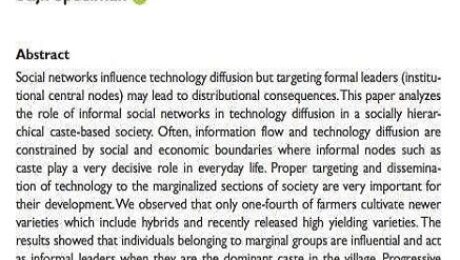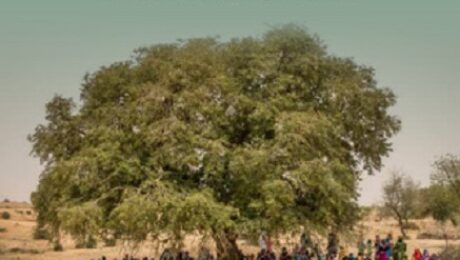Scaling Brief #2: Scaling Principles
Scaling of innovations is one of the key goals of the new CGIAR 2030 Research and Innovation Strategy and an important driver of the One CGIAR process, which is aimed at stronger integration of its capabilities, knowledge, assets, and people. These policy briefs were developed by CGIAR Science Leaders and scaling specialists to provide guidance for the design and implementation within the CGIAR initiatives around the world. They highlight scaling principles, approaches and tools as well as key terms of relevance to support food system transformation.
- Published in EXTENSION AND INNOVATION
Scaling Brief #1: Scaling Web Conference Series with the CGIAR Science Leaders
Scaling of innovations is one of the key goals of the new CGIAR 2030 Research and Innovation Strategy and an important driver of the One CGIAR process, which is aimed at stronger integration of its capabilities, knowledge, assets, and people. These policy briefs were developed by CGIAR Science Leaders and scaling specialists to provide guidance for the design and implementation within the CGIAR initiatives around the world. They highlight scaling principles, approaches and tools as well as key terms of relevance to support food system transformation.
- Published in EXTENSION AND INNOVATION
State of Social Inclusion in Nepal
this background, the Central Department of Anthropology (CDA) at Tribhuvan University undertook this study on the “State of Social Inclusion in Nepal (SOSIN).” The study aims to produce a nuanced understanding of the situation and dynamics of social inclusion and gender equality. Using both quantitative surveys and qualitative assessments, this research generates empirical data about the current state of equality and social inclusion in Nepal and allows for the tracking of progress. This research is a sequel to the research project “Social Inclusion Atlas and Ethnographic Profile (SIA-EP)” implemented by the then joint Department of Sociology/Anthropology at TU in 2012-2014 with support from the Norwegian Embassy in Nepal. The SIA-EP established a comprehensive national database disaggregated by gender, caste and ethnicity, built a Multidimensional Social Inclusion Index through re-analysis of major national surveys, and produced profiles of 42 highly marginalized caste/ethnic groups to understand the micro-dynamics of exclusion.
- Published in EXTENSION AND INNOVATION
Multilevel innovation platforms for development of smallholder livestock systems: How effective are they?
There is growing recognition that sustainable development of smallholder agriculture in Sub-Saharan Africa requires a systems approach. One response to this has been applying the agricultural innovation systems concept and the use of Innovation Platforms (IP) as tools for agricultural development. By providing social space and facilitating interactions among farmers, researchers and other stakeholders, IPs can promote collective action and foster innovation.
- Published in EXTENSION AND INNOVATION
An Evolving Paradigm of Agricultural Mechanization Development: How Much Can Africa Learn from Asia?
Agricultural mechanization in Africa south of the Sahara — especially for small farms and businesses — requires a new paradigm to meet the needs of the continent’s evolving farming systems. Can Asia, with its recent success in adopting mechanization, offer a model for Africa? An Evolving Paradigm of Agricultural Mechanization Development analyzes the experiences of eight Asian and five African countries. The authors explore crucial government roles in boosting and supporting mechanization, from import policies to promotion policies to public good policies. Potential approaches presented to facilitating mechanization in Africa include prioritizing market-led hiring services, eliminating distortions, and developing appropriate technologies for the African context. The role of agricultural mechanization within overall agricultural and rural transformation strategies in Africa is also discussed. The book’s recommendations and insights should be useful to national policymakers and the development community, who can adapt this knowledge to local contexts and use it as a foundation for further research.
- Published in EXTENSION AND INNOVATION
Developing Capacities For Agricultural Innovation Systems
The CDAIS project was designed to strengthen TAP through the development of a common framework for Capacity Development for Agricultural Innovation Systems (CD for AIS) which sets concepts and guidance for the promotion of agricultural innovation system (AIS) thinking and collaborative learning, and for the strengthening of capacities for AIS in tropical countries. The project tested this common framework (or so-called ‘TAP CF’) in eight pilot countries,1 offering a variety of situations across three continents. A transversal analysis of the project outcomes therefore intended to ‘validate’ the common framework, meaning to verify hypotheses underpinning the TAP CF and to verify how changes happened in the eight countries in relation with the mode of operationalization of the TAP CF by the CDAIS project. In other words, the transversal analysis sought to understand how the project produced outcomes, what these outcomes were in each country, so as to propose recommendations for upgrading the TAP Common Framework across its theoretical and practical dimensions.
- Published in EXTENSION AND INNOVATION
Transformation of our food systems – the making of a paradigm shift
In this book, the authors of the essays and short stories are illustrating, in a narrative form and their own words, the “behind the scene” stories about these and other landmark reports that have emanated from the IAASTD. It is hoped that with this book we attract the further attention of decision makers to the challenges, the solutions, and the actions necessary to address them. Food is a human right, and it is the responsibility of governments to ensure that all have access to the right quantity and quality of healthy food at an affordable price, which has been produced for the long-term from resilient systems, many of which must be rebuilt on the ruins of degraded soils, lost biodiversity and impoverished farmers. It’s high time that our food systems pay attention to the word regenerative, as sustainable and resilient systems can only function as such in fully restored ecosystems. Time is ripe to move from exploitation to management of our life supporting ecosystems.
With a major gathering planned under the auspices of the UN Secretary General, Food System Summit in 2021, managed by private foundations and private sector representatives, this book could not be timelier, bringing a strong warning that “business as usual is not an option”, and that if this is not heeded, it’s not people but the irrevocable damage to nature that will destroy our civilization. One could ask where were the initiators and leaders of the 2021 Food System Summit over the past 11 years? It is clear that food systems and the value of a “systems approach” has been suddenly (re)invented and re-interpreted. We must defend the narrative we have developed in 2009 and refined since, which is now very much in jeopardy again and keenly aware of the impacts of the cooptation of language while continuing on the same path. History has a tendency of repeating itself.
This book is a treasure trove for decision makers with any kind of responsibility across the food chain. It is also relevant to the general public as it explains clearly what the consequences of their choices are. Our hope is that decision makers, NGO officials and the wider public read this book and do their absolute best to implement its lessons – our current and all future generations will be eternally grateful if they do.
- Published in EXTENSION AND INNOVATION
The Innovation Revolution in Agriculture
This book defines innovation as “significant, positive change” that innovators work for and hope to achieve. Examples include increases in crop yields due to better management and improved seeds. Productivity growth underpins food and nutrition security, poverty reduction, and the conservation of natural resources. It arises when farmers adopt improved technologies and practices developed by R&D efforts, often paid for by governments or private investors. Adoption is the “prize.” There is no market for innovations without user adoption nor any scope for impact or investor reward. Understanding adoption is therefore key.
- Published in EXTENSION AND INNOVATION
Caste, Social Networks and Variety Adoption
Social networks influence technology diffusion but targeting formal leaders (institutional central nodes) may lead to distributional consequences. This paper analyzes the role of informal social networks in technology diffusion in a socially hierarchical caste-based society. Often, information flow and technology diffusion are constrained by social and economic boundaries where informal nodes such as caste play a very decisive role in everyday life. Proper targeting and dissemination of technology to the marginalized sections of society are very important for their development. We observed that only one-fourth of farmers cultivate newer varieties which include hybrids and recently released high yielding varieties. The results showed that individuals belonging to marginal groups are influential and act as informal leaders when they are the dominant caste in the village. Progressive farmers are found to fail in disseminating new varieties, and targeting influential informal leaders who belong to the dominant caste of the village appears to be a better strategy. Among non-dominant caste members, influential leaders belonging to Other Backward Classes (OBCs) or Scheduled Tribes (STs) are more desirable targets than other caste groups. The more concentrated a network is in terms of its caste composition, the faster will be the spread of any technology.
- Published in EXTENSION AND INNOVATION
Agricultural extension: Global status and performance in selected countries
Agricultural transformation and development are critical to the livelihoods of more than a billion small-scale farmers and other rural people in developing countries. Extension and advisory services play an important role in such transformation and can assist farmers with advice and information, brokering and facilitating innovations and relationships, and dealing with risks and disasters. Agricultural Extension: Global Status and Performance in Selected Countries provides a global overview of agricultural extension and advisory services, assesses and compares extension systems at the national and regional levels, examines the performance of extension approaches in a selected set of country cases, and shares lessons and policy insights. Drawing on both primary and secondary data, the book contributes to the literature on extension by applying a common and comprehensive framework — the “best-fit” approach — to assessments of extension systems, which allows for comparison across cases and geographies. Insights from the research support reforms — in governance, capacity, management, and advisory methods — to improve outcomes, enhance financial sustainability, and achieve greater scale. Agricultural Extension should be a valuable resource for policymakers, extension practitioners, and others concerned with agricultural development.
- Published in EXTENSION AND INNOVATION
